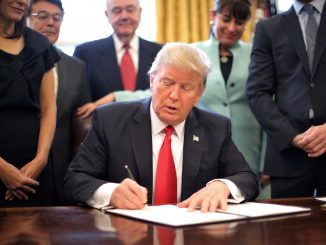
There’s nothing like a good “Aha!” moment. We all have them — whether you’re trying to remember the name of a song, solve a problem at work, or remember what was on that grocery list you left on the kitchen counter, a light bulb in your head turns on and suddenly something clicks. In fact, Merriam-Webster defines this term as a moment of sudden realization, inspiration, insight, recognition, or comprehension.
Last week, America had a real “Aha!” moment when President Donald Trump signed into law a package of bipartisan bills that will change the way we address the opioid crisis and ultimately save lives. This is the most significant federal effort against a single drug crisis in history, and I was proud to be the only North Carolina Representative to join President Trump at the White House for this important moment.
As a leader on the Energy and Commerce Committee, the committee responsible for addressing health issues, I’ve been involved in shaping this opioid legislation every step of the way. I’ve been working with my colleagues, the Trump Administration, local leaders, law enforcement, health care professionals and members of our community fighting addiction to find the best ideas to combat the opioid crisis. In fact, I had three bipartisan bills included in the package, and I’m humbled to see so many people work together on this issue. It’s a reminder that amid all the rancor in Washington, Republicans and Democrats can actually set aside differences for the good of the nation.
The legislation President Trump signed into law focuses on all stages of the opioid crisis, including prevention, treatment and recovery. It takes steps to protect communities from illicit drugs by empowering law enforcement and leveraging federal resources at the local level. It also gives doctors tools to identify and support at-risk patients while reducing the amount of dangerous drugs available to the public.
For me, my “Aha!” moment in these efforts was realizing we needed to do more and find better ways to dispose of excess opioids. I spoke with a constituent who had moved several times, and with every move she would shift her old, unused prescription pills from one medicine cabinet to the next. In fact, according to the Journal of the American Medical Association, less than 10 percent of patients dispose of their excess opioids properly.
By preventing unused pain medicine from falling into the wrong hands, we can save countless lives. Think about it: when pain pills go unused, they frequently sit in medicine cabinets for months or years on end. I’ve heard firsthand from local realtors about folks posing as homebuyers just to go through medicine cabinets at open houses. And the statistics back this up — some eighty percent of heroin users first misused prescription opioids. That’s why I took the lead on finding solutions to fight this crisis from the packaging and disposal angle.
Everywhere I go in our district, I regularly hear horror stories about the opioid crisis — just last month alone there were 484 overdose visits to hospitals across the state. Stanly County had the highest number of these instances while Cabarrus County and Cumberland County were close behind. With this significant federal action, we’re getting more resources to our communities and more folks on the front lines. While there’s still much work to do, I’m hopeful this bipartisan legislation will go a long way towards turning the corner on this crisis.



